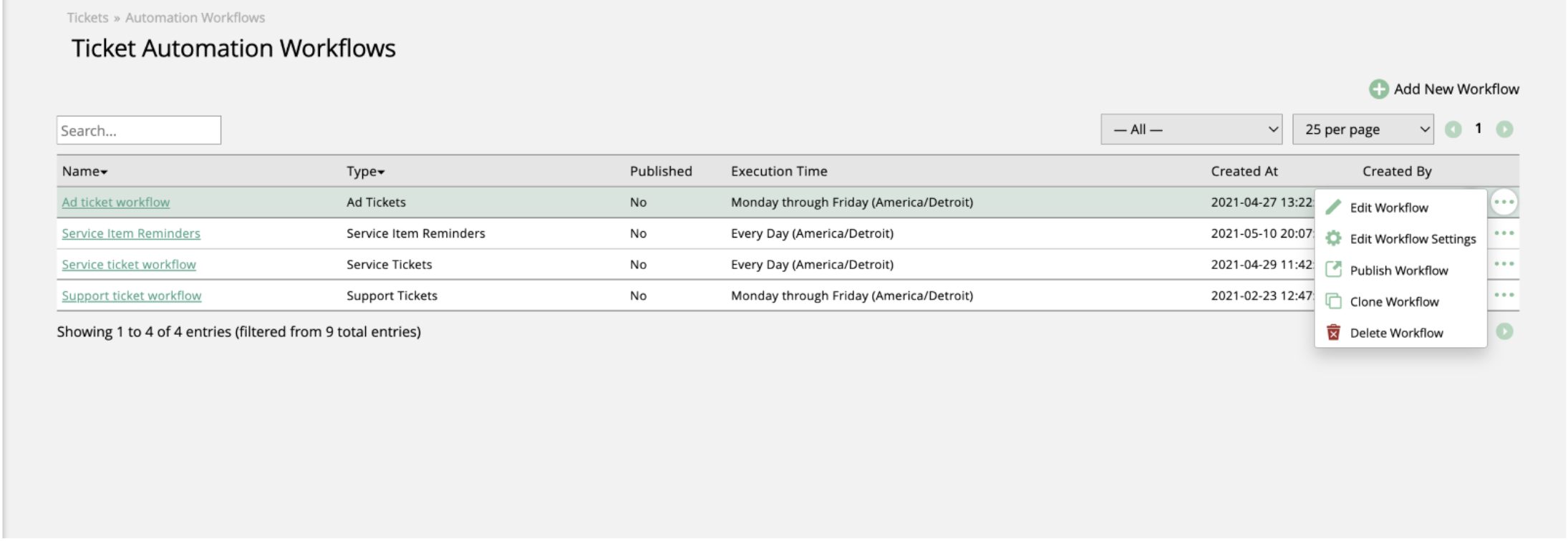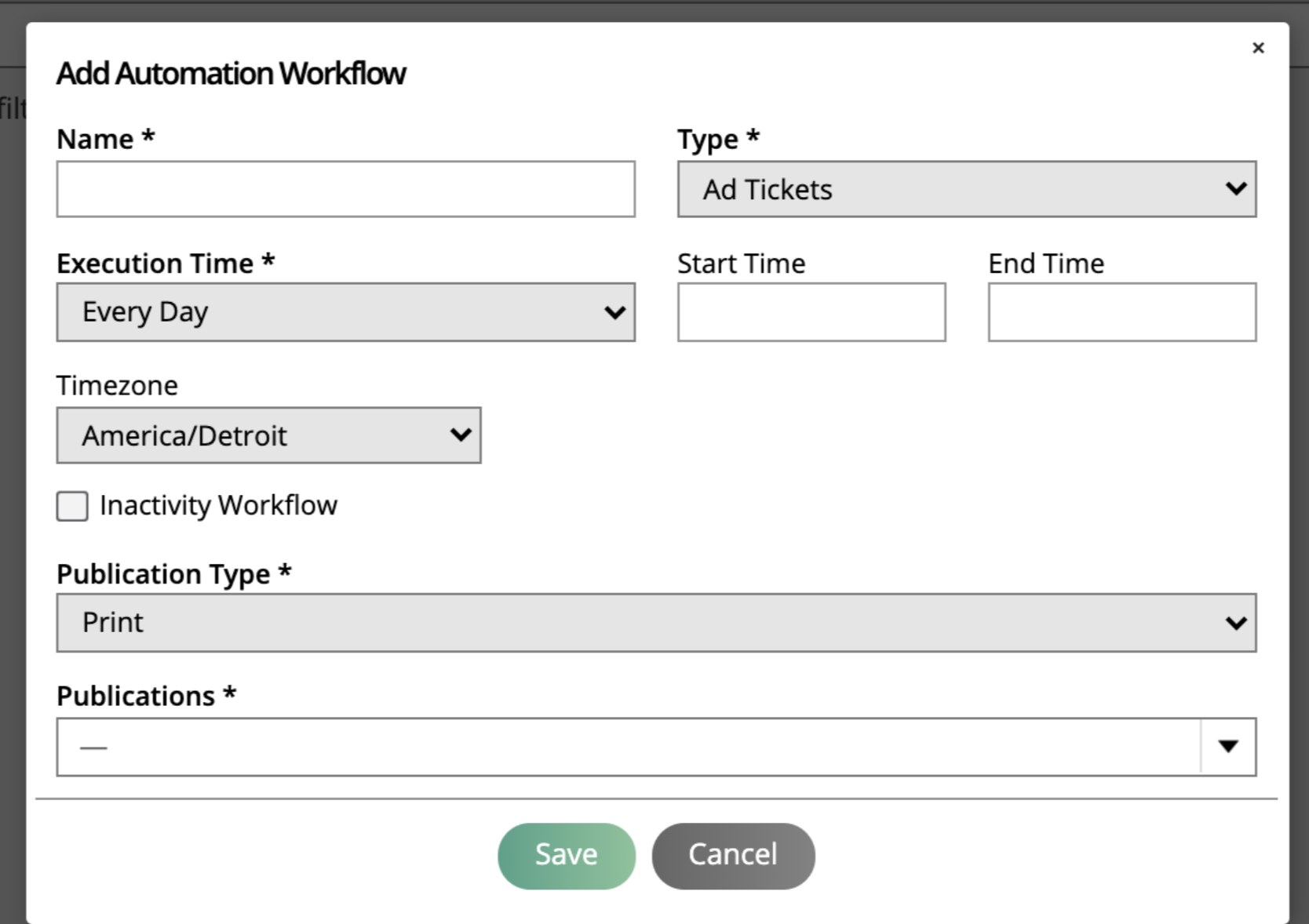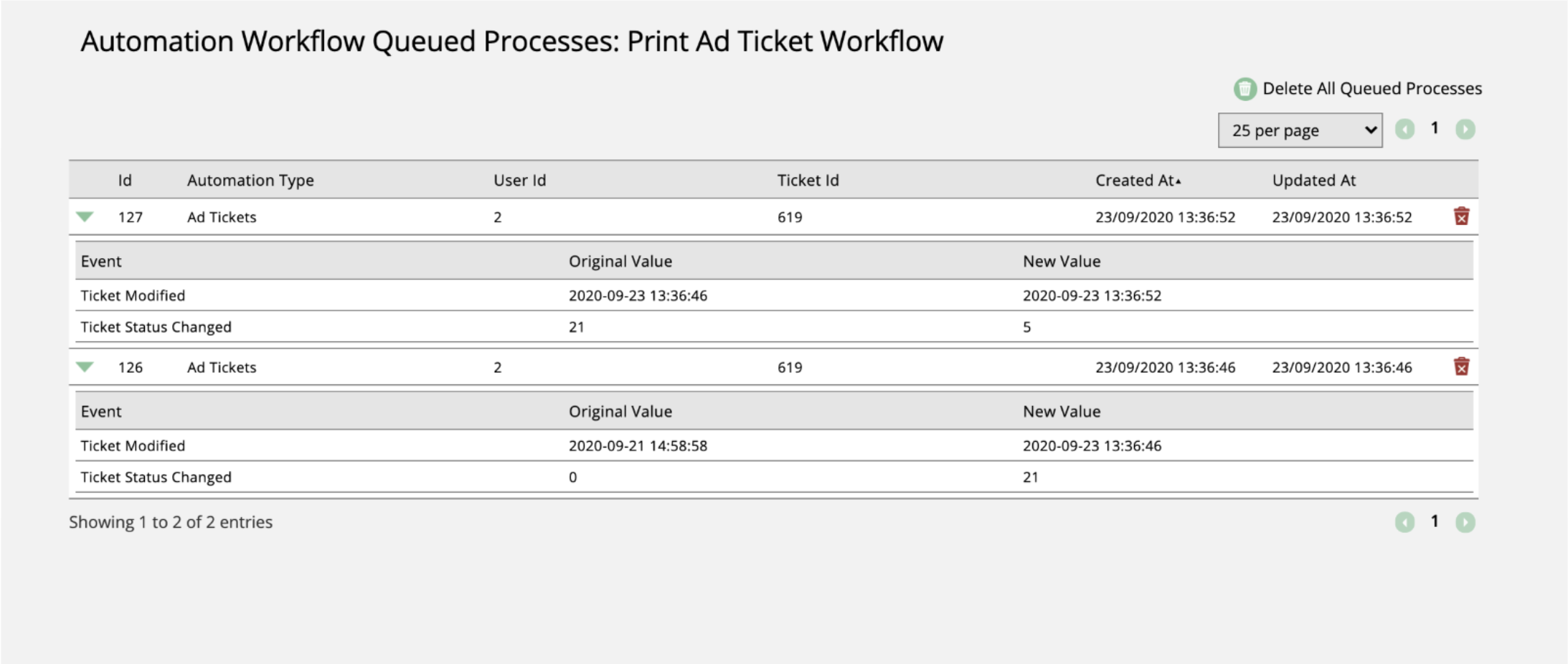Ticket Inactivity Workflows
Inactivity Workflows are a specific type of ticket automation. Tickets go through these workflows when they have not had any activity after a specified amount of time. Inactivity Workflows are particularly helpful in making sure that tickets don’t fall through the cracks, and ensure they are being worked on.
To create ticket workflows, go to Tickets > Automation Workflows. You can click the + icon in the upper right corner to create a new workflow, or if you already have some created, you can use the ellipses icon in the table to edit an existing workflow.

In the Add Workflow popup, you’ll be able to choose which type of workflow you want to create. You can create inactivity workflows for all ticket workflow types (ad tickets, digital media tickets, etc.) except for Service Item Reminders.

Once you’ve chosen the type, pick your execution times. You can choose from either every day, or Monday through Friday if you only want the automation to run during the work week. You can also set a start and end time if you wish.
Next, you’ll see a checkbox to determine if you want your workflow to be an ‘Inactivity Workflow’. Since this document is specifically for inactivity ticket workflows, make sure you check this box. For more information about normal ticket workflows, please reference the Ticket Automation Workflows help center page.
No matter which ticket type you are using, after you select Inactivity Workflow, you will need to choose the Number of Days Inactive. The options range from 1 Day inactive to 30 Days inactive. The value set here is what will prompt tickets to go through your workflow, in addition to the ticket type criteria such as publication or ad size.
Depending on which ticket type you selected for your workflow, the information required for the next section of the workflow will vary.
Ad Tickets
For ad ticket workflows, you will be required to choose if your workflow will be for print or digital publications. You cannot have both in a single workflow. Once you choose print or digital, choose the publications you wish the workflow to apply to. If you wish to get even more granular, you can choose specific ad sizes as well. Ad sizes are not a required field to create your workflow.
Digital Media Tickets
Choose your inventory type. You can only have one inventory type per workflow. For example, you may have one workflow for Impression products, and another for Slot. Once you choose your inventory type, you will be required to select both the product category and products that the workflow will be applied to. If you want to have a more granular workflow, you also have the option of choosing specific publications. The publication list is populated after you’ve chosen your products.
Event Tickets
For event ticket workflows, you are required to choose an event, and the products from the event you wish the workflow to apply to. You’ll notice that only Booth/Sponsorship products show up as options here, which is because ticket sales do not create service tickets in Ad Orbit.
Service Tickets
Service ticket workflows require you to choose a product category, and the products the workflow will apply to.
Support Ticket
Very similar to the service ticket workflows, all that is required for support tickets is the product category, and products the workflow will apply to.
Once you’ve created your workflow, the next step is to add triggers and actions. To do this, either click on the workflow name in the table, or use the ellipses icon on the right side and click Edit Workflow.
Here, you can use the + icon to add new actions, and set the action types and conditions in the popup. You can always edit existing actions by using the pencil icon, or remove an action by using the trash can. There are a few action types for Inactivity workflows.

If/Then Branches: For If/Then Branch actions, you must choose a condition that will trigger the action. The only available condition for Inactivity workflows is ‘Current Ticket Status’. This condition finds all tickets with a current status, and will send tickets with that status down the Yes branch, and tickets that do not have that status down the No branch.
Send Slack/Microsoft Teams Message: Send a message to a Slack or Microsoft Teams Channel to alert someone of a ticket update.
Send Internal Email: Send an email to a user to alert them of a ticket update.
Delay: Have the system wait before moving to the next step. For example, you may want to wait a few days after a ticket status is changed and then send a reminder if the status is the same.
Set Ticket Owner: Assigns a specific user to the ticket.
Update Ticket Status: Change the ticket status based on the previous trigger.
Mark Ticket as Done: Set the ticket status to Done.
Mark Upload as Final: Marks the upload as final once complete.
Note
Anywhere there is an exclamation icon means that the workflow is incomplete, and you need to add another action by clicking on the + icon. You will not be able to publish the workflow until this is resolved.
Publishing the Workflow
When you are finished creating your workflow, the next step is to publish the workflow so that your tickets can begin flowing through it. You can click Publish on the page where you add the actions, or by using the ellipses icon and clicking the Publish button on the main ticket automation page.
On the page where you set up the workflow actions, you can view information about the items that are going through the published workflow.
Click on the details icon in the upper right corner of each action to see the action and the conditions. You will not be able to edit the action when the workflow is published.
There will be numbers in the actions that show how many tickets are currently being processed at that stage of the workflow. You are able to click on these numbers, and they will take you to different pages depending on the action and the color. All of the pages will give you more information about the tickets that are at that particular stage.
At the very top of the workflow is a grayed out box that may also have numbers in it. If you click on these numbers, if will take you to the Queued Processes page. On this page, you can see more detailed information about the tickets that are about to go through the workflow. You are able to delete queued processes from this page if you would like, on an individual or a bulk basis.


For the rest of the workflow, if you see a number that is orange, it means the status for the action is ‘pending’. This will be very common especially for Delay actions. If you see a green number, it means the status for the action is ‘success’. If the number is red, it means a status of ‘failed’, and the item did not pass through that stage of the workflow. Clicking on any of the numbers will take you to the Automation Workflow Executions page which displays information about the action and status.


At the top of an If/Then Branch, you can see how many tickets went in each direction, and you can use the process IDs as reference to track the specific item throughout the workflow.
New 7/2/2024